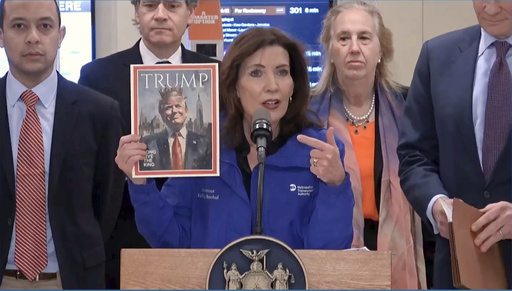
NEW YORK — On Wednesday, the Trump administration issued an order to abandon the congestion pricing plan aimed at reducing traffic in New York City and funding mass transit by charging fees for driving into the heart of Manhattan. The program, which began on January 5, utilized license plate recognition technology to collect a toll of $9 from most vehicles entering areas south of Central Park. Initial reports from transit officials indicated that this toll had led to slight but noticeable decreases in traffic levels.
U.S. Transportation Secretary Sean P. Duffy announced that the federal government has withdrawn its support for the congestion pricing initiative, characterizing the financial implications of the toll as “a slap in the face” to working-class Americans and small business owners. The Federal Highway Administration will collaborate with New York state authorities to facilitate an “orderly termination” of the toll system.
In response, the Metropolitan Transportation Authority (MTA), which manages the subway and other public transit options in New York City, promptly initiated a federal lawsuit to seek the continuation of the congestion pricing. Governor Kathy Hochul, a Democrat, asserted that the toll program would remain operational while the legal proceedings unfold.
President Trump, whose properties, including the iconic Trump Tower, fall within the congestion pricing zone, expressed satisfaction with the development, announcing its demise on his social media platform, Truth Social. He proclaimed, “CONGESTION PRICING IS DEAD. Manhattan, and all of New York, is SAVED,” further exclaiming, “LONG LIVE THE KING!” The White House later shared an image of Trump donned with a crown against the New York skyline.
Hochul swiftly countered Trump’s remarks, noting, “New York hasn’t labored under a king in over 250 years,” and emphasized, “We sure as hell are not going to start now.”
The toll program had faced mixed reactions. While major global cities like London and Singapore have implemented similar systems to encourage public transportation use by making driving costs significantly high, this strategy was unprecedented in the U.S. New York planned to use the revenue collected from these tolls to help secure bonds for vital upgrades to its aging transit infrastructure, which serves around 4 million daily riders. The fee structure was designed with variability based on vehicle size and time, with heavier vehicles paying more, and reducing to as low as $2.25 during off-peak hours—less than a subway fare.
Opposition to the tolling system mainly stemmed from suburban commuters and individuals in areas withlimited subway access. Advocates for transportation and environmental reforms praised the initiative as a forward-thinking measure to decrease air pollution and facilitate smoother traffic patterns for essential vehicles such as delivery trucks and emergency services.
State Senator Andrew Gounardes, a Democrat from the city, criticized Trump’s decision, stating, “By blocking this successful policy, Trump will be directly responsible for more traffic, more crashes, more polluted air, slower buses and less funding for our transit system.”
Though the plan received approval from New York lawmakers in 2019, it encountered delays due to a federal environmental review during Trump’s presidency, but gained approval under President Biden’s administration. Despite several legal challenges aimed at reversing the toll, it managed to proceed. Notably, New Jersey’s Democratic Governor Phil Murphy had also opposed the program, even appealing to Trump on Inauguration Day to discontinue it.
Hochul had expressed reservations about the tolling system earlier, pausing its initial rollout in June due to concerns about economic impacts on local businesses. However, she reinstated the program in November following Trump’s election victory, reducing the passenger vehicle toll from $15 to $9 in the process. Since then, Hochul praised the program as a success for the city and engaged with the president on the matter multiple times.
New York City Mayor Eric Adams, also a Democrat, was initially in favor of congestion pricing but appeared hesitant to take a stand amid the ongoing conflict between Trump and the state. In remarks to journalists, Adams commented, “If the federal government has the authority to do something within their powers, then we can’t sit back and complain about it, because we do things within our powers.”

